In what felt like an appetizer to the French main course coming up this Wednesday, Barcelona hosted relegation-bound Rayo Vallecano at the Camp Nou in La Liga. The Catalans needed some time to wake up but managed to get the big three points to maintain their distance in front of Atletico Madrid, who still sit in second place.
Even though Ernesto Valverde probably wished the game could have been done and dusted earlier, an almost full strength Barcelona side had a lot of trouble breaching a well-organised and compact Rayo Vallecano defence. This tactical analysis will use statistics to determine just how the league leaders managed to come back from yet another deficit to snatch all the spoils at their home ground.
Lineups
Barcelona (4-3-3)
Starting XI: Ter Stegen – Semedo, Pique, Umtiti, Alba – Arthur, Busquets, Vidal – Messi, Suarez, Coutinho
Bench: Cillessen, Murillo, Aleñá, Rakitić, Sergi, Malcom, Dembélé
Coach: Ernesto Valverde
Rayo Vallecano
Starting XI: Dimitrievski – Advincula, Emiliano, Galvez, Amat, Moreno – Comesaña, Imbula – Bebe, Alvaro – de Tomás
Bench: Alberto Garcia, Tito, Mario, Embarba, Pozo, Trejo, Di Santo
Coach: Michel
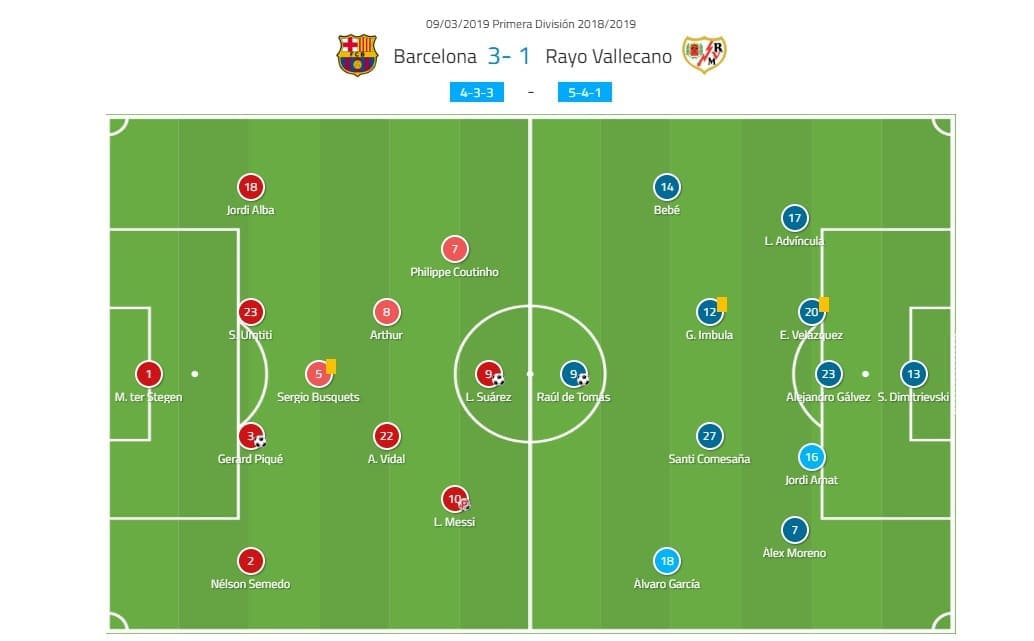
Barcelona setup
There were two ways Ernesto Valverde could have looked at this game: as an opportunity to rest players before a crucial Champions League clash against Lyon, or as a potential banana skin.
The pragmatic and cautious coach that he is, Valverde decided to field a semi-rotated Barcelona lineup that had most of its big guns on the pitch but also rested a couple of key pieces of the puzzle.
With that in mind, Ivan Rakitić, Ousmane Dembele and Sergi Roberto found their way onto the bench while Arturo Vidal, Philippe Coutinho and Nelson Semedo deputised for them. Clement Lenglet was suspended due to yellow card accumulation and was, therefore, replaced by Samuel Umtiti who is still regaining his full match sharpness. The choice of personnel who were rested was, once again, a hot topic of debate amongst the public but it all worked out in the end for the Catalans.
Barcelona were deployed in an all-too-familiar 4-3-3 system but then transitioned to 4-4-2 and seemed to stay that way until the end of the game.
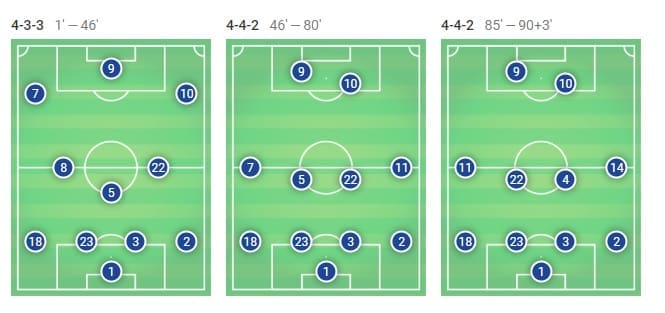
Rayo Vallecano setup
Michel’s troops have definitely seen better days as Rayo Vallecano came to the Camp Nou searching for their first win in five bad games. Although it all started brightly and the guests not only scored first but also seemed like they could go the distance by keeping Barcelona at bay at all times, things started to fall apart pretty soon for them.
Still, the coach of the Madrid team made four changes from their last game, which they lost 2-0 to Girona at home. Abdoulaye Ba is still serving his red card suspension so he was sidelined for the game, and in his place came the Uruguayan Emiliano Velazquez.
But instead of their traditional four-man squad at the back, Michel deployed a five-man back line of Luis Advincula, the aforementioned Velazquez, Alejandro Galvez, Jordi Amat and Alex Moreno.
Gianelli Imbula and Bebe were the remaining two changes in midfield behind the danger-man Raul De Tomas up front. Rayo Vallecano played in a 5-4-1 system and prioritised a defensive mindset throughout the whole game.
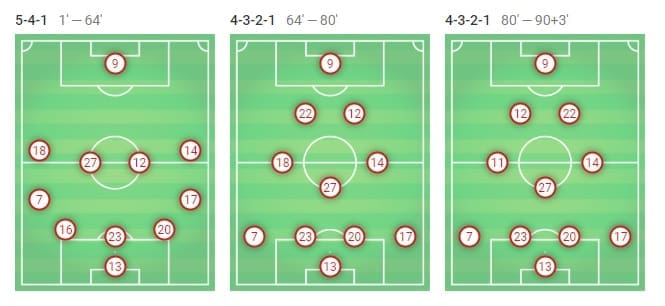
Early struggles
Even though this game had a David vs Goliath vibe around it, Rayo Vallecano knew their game plan perfectly. Early on, they were extremely successful against Barcelona who had troubles solving the puzzle.
Rarely anyone can come to the Camp Nou and be the dominant team, dictate play and be the more aggressive or proactive side on the pitch. The guests from Madrid never tried asserting themselves in that way. Instead, they turtled up, soaked up all the pressure and tried to strike on the counter. They might not have been the first to implement this strategy in the heart of Catalunya, but they made it work nonetheless.
The trick was to minimalise the space Barcelona’s passes could go through. The route to the final third was sealed behind nine men forming a narrow low block, and staying as close to each other as possible.
Notice in the image below how Rayo shift all their manpower to the side where Barcelona’s ball-carriers are, and make sure to close all passing channels to their forwards.
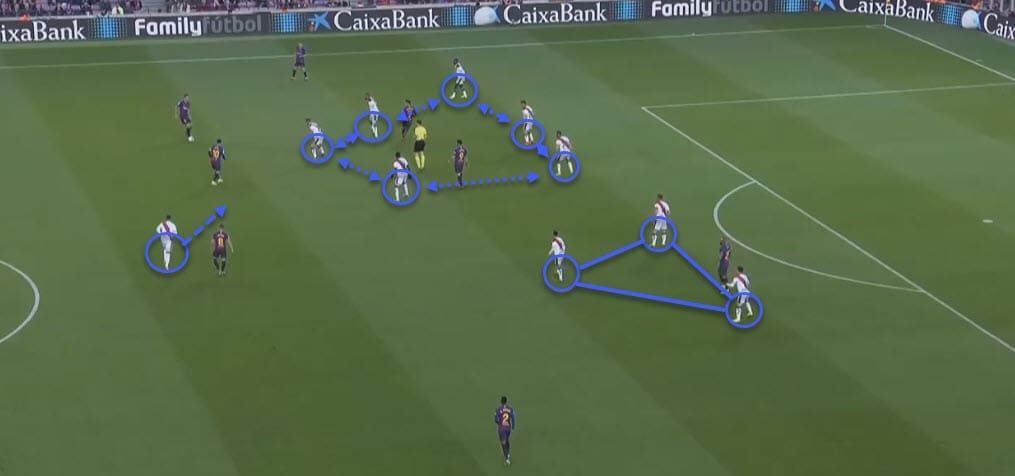
This worked extremely well as Barcelona had to wait until the 23rd minute to get their first shot on target, and even that was mostly harmless as Lionel Messi’s attempt racked up just a meagre 0.08 xG value. Things looked good for Rayo as they completely blunted Barcelona and made them pass the ball without much meaning, like a vulture circling its prey.
Things even took another swift turn in favour of the boys from the capital as the Real Madrid loanee, Raul De Tomas, hit the net from the edge of the box against the run of play and from an inferior position.
Generally speaking, Rayo attacked more through their right side, utilising Bebe’s physical advantage over Jordi Alba which resulted in a total of 44% of all of their attacks running down that flank.
However, the goal itself arrived from the opposite side. While a piece of Raul De Tomas individual brilliance added some extra substance to it, it was also a Barcelona weakness exploited to the fullest.

This image above depicts Barcelona’s right and Rayo Vallecano’s left side, and how it looked for the majority of the game. Both away team’s players are completely unmarked and free to receive the ball. Messi, for all his brilliance, rarely drops back to defend, and in a midfield trio of Sergio Busquets, Arthur Melo and Arturo Vidal, the Chilean was tasked to be the most aggressive one.
That meant that Vidal would not really be in his position prescribed by the team sheet but would often find himself higher up the pitch, pressing and winning the ball back. While he did exactly that, and did it almost flawlessly with three interceptions and a colossal 17 recoveries, due to his higher positioning the right flank was mostly deserted.
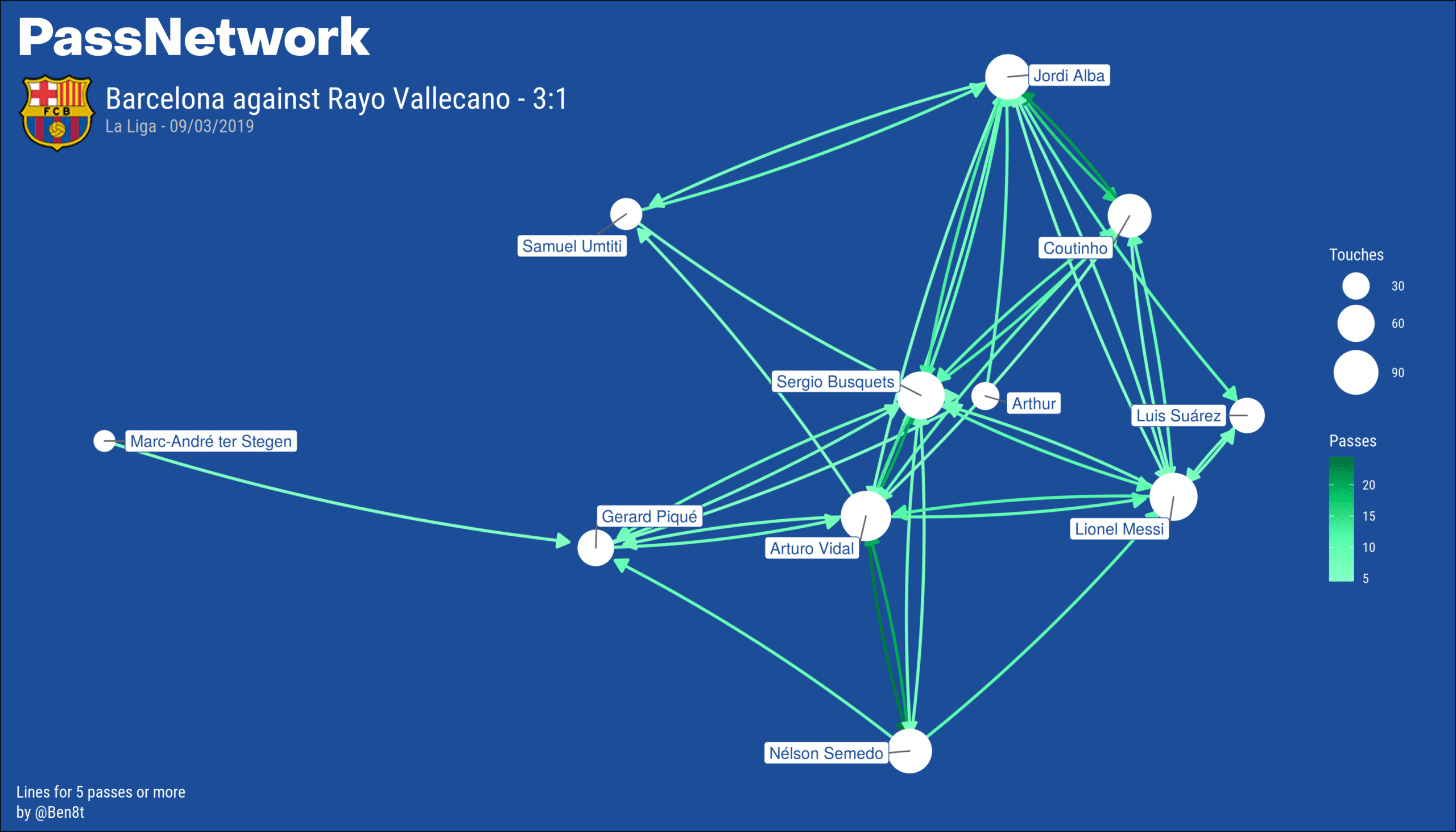
By taking just a small look at Barcelona’s pass-map, we can see the difference in the sheer number of touches on both sides. The left is really proactive, and most things went through there, while the right is non-existent in attack but also defensively exposed due to not enough personnel being there at all times. The Catalans had to get creative and had to do it quickly.
Barcelona adapt and overcome
Since Rayo Vallecano’s troops were rigid in staying in their compact shape and not moving an inch, Barcelona had to force them to break the formation. With the setup Ernesto Valverde had opted for, there were several options available to him which he could try out without tampering with the personnel.
The first thing he thought of and instructed the players to do from the start was Messi and Vidal swapping positions. This is actually a common occurrence when both of those players are on the pitch at the same time.
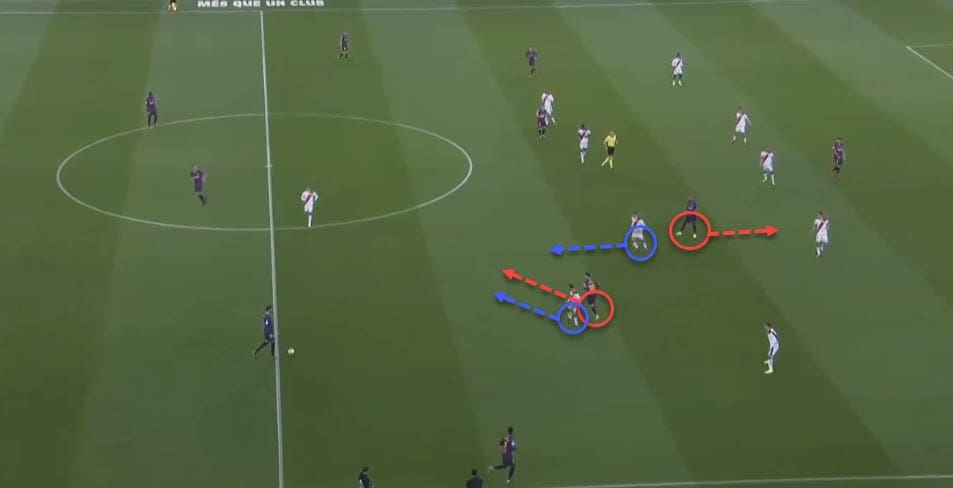
This does two things for Barcelona. Firstly, the little Argentine gets to drop into midfield and try to be the creative spark in a trident that usually overwhelmingly lacks just that. Since that deprives Barcelona of an important attacking piece of the puzzle, Vidal shifts to the final third to try and bring some aggression in the opposition’s face.
That in itself is the second part of the swap. The Chilean got to venture higher up the pitch to be one of the first men to press Rayo Vallecano’s backline in case of a lost ball, or simply try to move the pieces out of position when Barcelona were on the attack.
But Arturo Vidal and Lionel Messi were not the only ones doing that. Luis Suarez also had a big role in being extremely mobile and annoying to defend against in the final third.
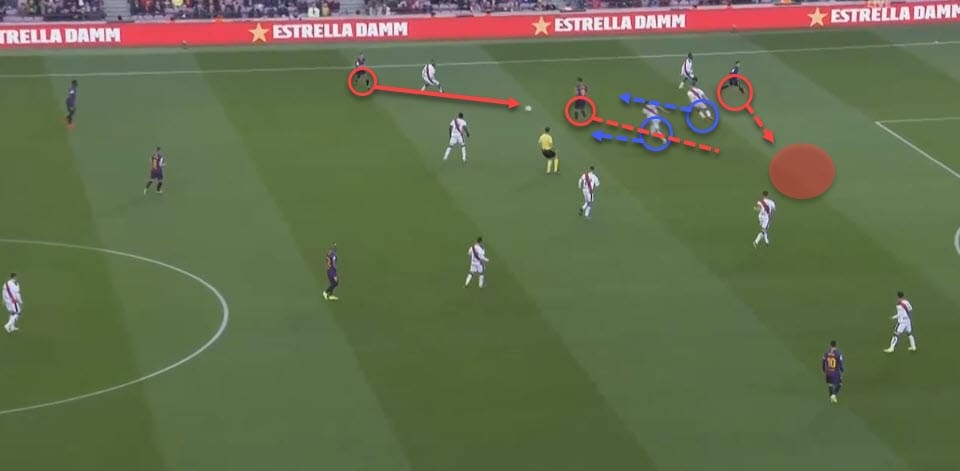
Notice how Suarez always drops deeper to receive the ball, dragging multiple markers with himself and creating space for the teammate swapping places with him. In this case, it is is Philippe Coutinho who tries getting in behind the defensive line of the opposition.
This happened on multiple occasions throughout the match. There was always the same goal of disrupting Rayo Vallecano’s compact block and manipulating the defence out of shape as much as possible.
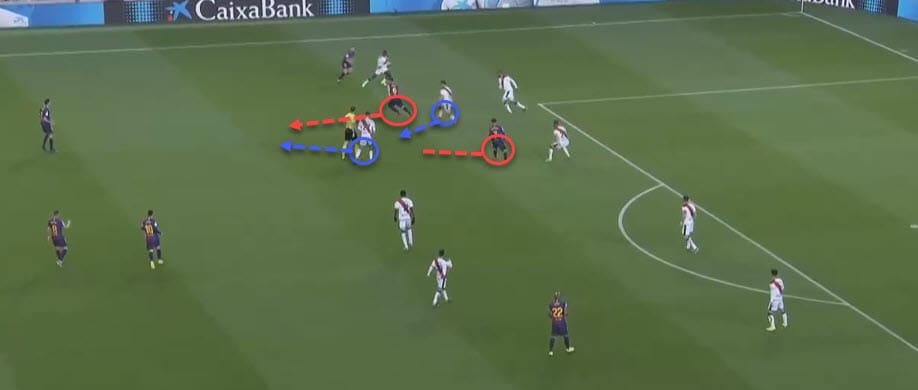
In the end, when push came to shove, Barcelona had to rely on different outlets to finally find the net. Both the goal to tie things down and the one to complete the comeback came from set pieces; one from Messi’s pinpoint free kick onto Gerard Pique’s head, and the other from the Argentine’s penalty.
This in itself comes as a surprise since the Catalans rarely threaten the opposition from set pieces, apart from direct free kicks from the big man. Desperate times call for desperate measures, right?
If it ain’t broke…
What did seem to really work for Barcelona, though, was the high press. Rayo did not see much of the ball for most parts of the game (36.52% possession) but when they did have it, the Catalans were in their faces, as already mentioned.
This yielded a lot of lost balls. Granted, the visitors lost fewer balls than the home team (96-81) but the difference was that 42% of all of Rayo’s losses of possession happened in their own first third of the pitch.
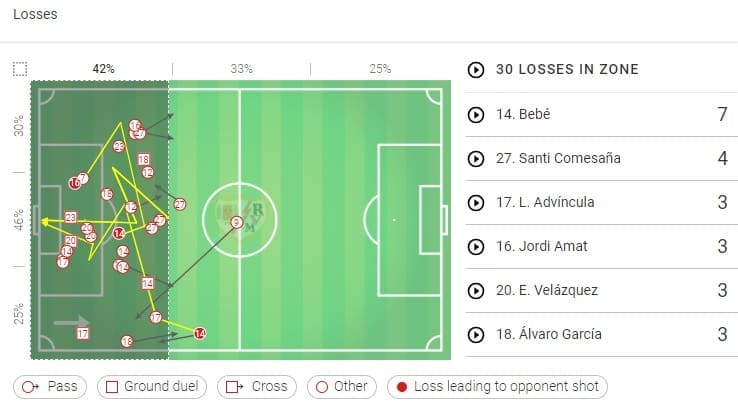
One of those losses led to a true Barcelona-style attack. Coutinho starts it off with a great recovery really high up and immediately after taking the ball away, the Brazilian sends it towards Messi.
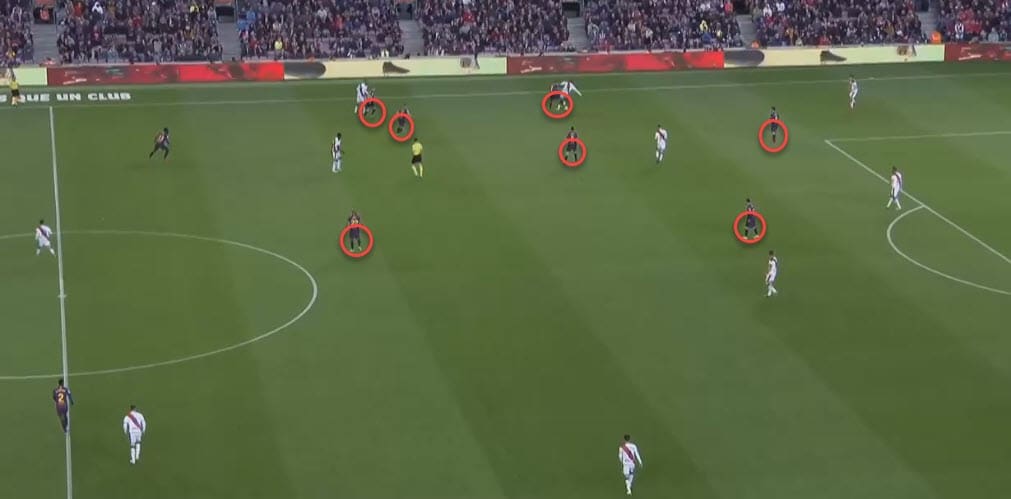
But instead of taking the ball, Messi makes a quick step-over and leaves it for Arturo Vidal who was charging into the final third. The Chilean returns the favour by giving the ball back to Messi, and in a couple of touches Barcelona had a real goalscoring opportunity.
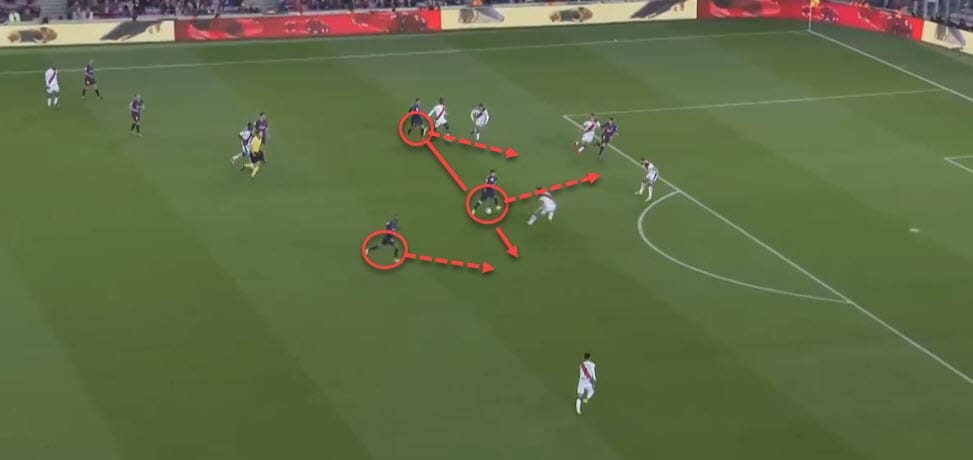
Unfortunately, Coutinho, who started it all, ends it with a weak shot right into the goalkeeper’s arms. But all of that aside, there was something that was really troubling Rayo Vallecano and their usually well-organised defensive mechanisms.
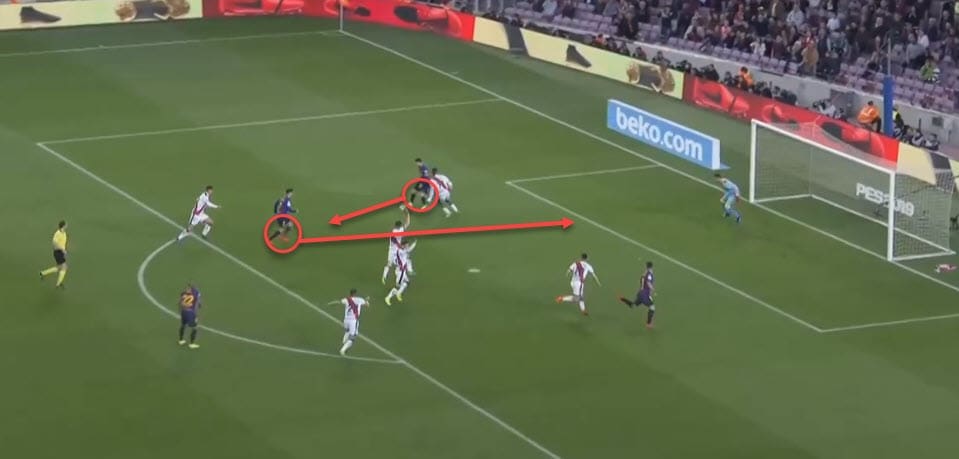
Who else but Ivan Rakitić was the final ace in Valverde’s sleeve. Barcelona’s Croatian sensation came off the bench to replace Coutinho and made an immediate impact.
Barely two minutes after his substitution, Rakitić adopted his attacking role and it led to Barcelona’s third goal. It was no coincidence, either. Even though it might seem that his inclusion was more of a defensive move, in the midfield trident of Busquets, Vidal and Rakitić, the Croatian is often tasked with being the one closest to the opponents’ goal.
This was the case against Rayo Vallecano as well. Notice below how Rakitić makes a darting run into the final third, just seconds after he started it all with a pass from deep. This comes naturally to the Croatian since he was originally an extremely attacking-minded player, at least in his youth.
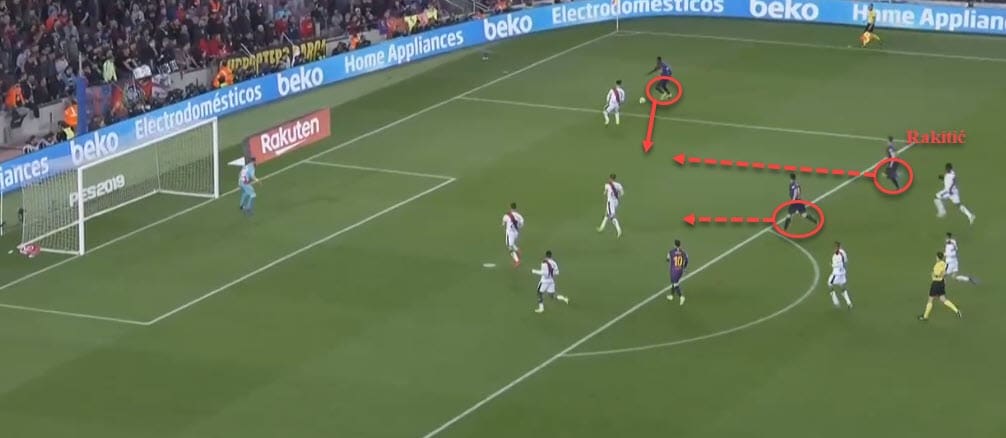
Suarez seals the three points after Rakitić leaves the ball for him on a silver platter. It calmed Barcelona’s nerves, giving Rayo Vallecano their sixth consecutive defeat in La Liga, and most likely Michel his one-way ticket out of the club.
Conclusion
Another night at the Camp Nou passed without many magic touches or moves to raise your heartbeat, but Barcelona managed to secure the win with a performance that wasn’t close to their best. Their minds seem to already be set on Lyon, and having played four away games in the last 21 days, this sequence of home matches will do them a lot of good.
Rayo Vallecano did not look like a team that is desperately trying to keep their heads above the water but they couldn’t keep Barcelona away from their goal for the entirety of the game. They did, however, show good defensive prowess and organisation. Unfortunately, it wasn’t enough to get anything from this game.
Now we once again shift our focus to the Champions League. Following upset after upset from previous weeks, the game against Lyon cannot come any sooner.
________________________________________________________________________
If you love tactical analysis, then you’ll love the digital magazines from totalfootballanalysis.com – a guaranteed 100+ pages of pure tactical analysis covering topics from the Premier League, Serie A, La Liga, Bundesliga and many, many more. Pre-order your copy of the March issue for just ₤4.99 here, or even better sign up for a ₤50 annual membership (12 monthly issues plus the annual review) right here.

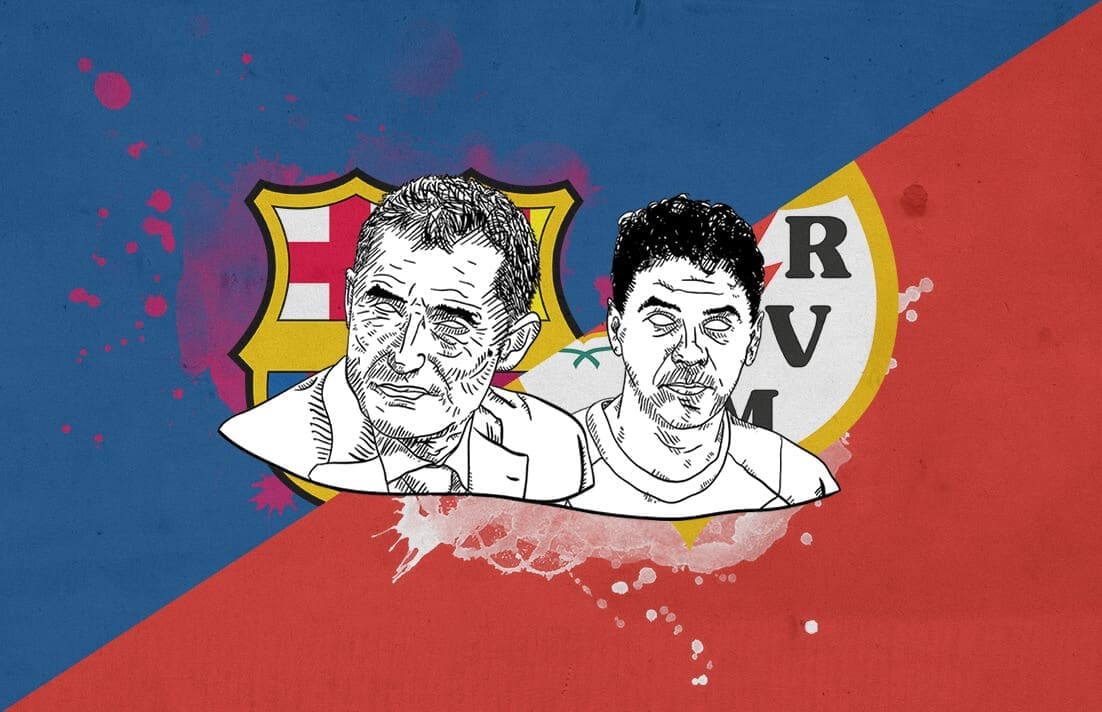



Comments